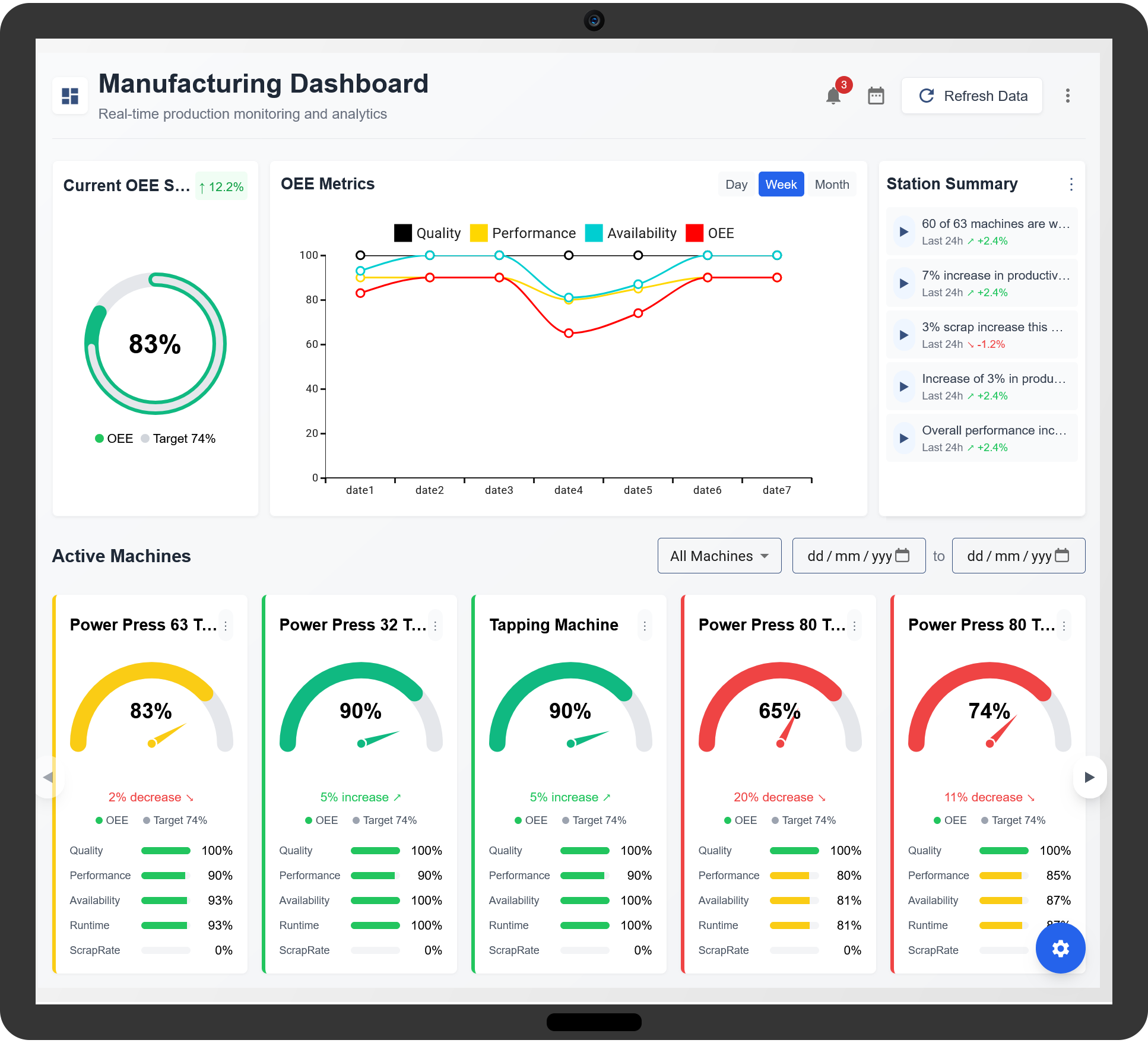Overall Equipment Effectiveness (OEE) is a critical metric for assessing the efficiency and productivity of manufacturing operations. It helps businesses identify performance gaps, reduce downtime, and enhance overall output. By implementing an OEE tracking system, manufacturers can gain real-time insights into machine availability, performance, and quality, leading to continuous process improvements.

1. Understanding OEE Tracking
OEE tracking involves measuring and analyzing key factors that impact production efficiency. The three core components of OEE are:
- Availability: Measures the time equipment is operational versus planned production time.
- Performance: Evaluates whether machines are running at their optimal speed without slow cycles or micro-stoppages.
- Quality: Tracks the number of defect-free products compared to total output.
By continuously tracking these metrics, manufacturers can pinpoint inefficiencies and implement corrective actions.
2. Benefits of OEE Tracking
Effective OEE tracking provides several advantages, including:
- Reduced Downtime: Identifies causes of unplanned stoppages and enables predictive maintenance.
- Improved Machine Utilization: Ensures equipment operates at peak efficiency with minimal idle time.
- Enhanced Quality Control: Detects defect trends early to minimize scrap and rework.
- Data-Driven Decision-Making: Offers actionable insights for continuous improvement.
- Increased Productivity: Optimizes production flow by eliminating bottlenecks and inefficiencies.
3. How to Monitor and Track OEE Effectively
Implementing a structured approach to OEE monitoring ensures accurate data collection and analysis. Below are the essential steps:
Step 1: Define Key Performance Indicators (KPIs)
Establish clear performance targets for availability, performance, and quality. Setting realistic benchmarks helps track progress and measure improvements over time.
Step 2: Automate Data Collection
Manual data tracking is prone to errors and inefficiencies. Implementing an automated OEE tracking system ensures real-time data capture, reducing inaccuracies and improving response time.
Step 3: Monitor Downtime Causes
Unplanned stoppages are a significant contributor to reduced OEE. By tracking downtime events, manufacturers can analyze root causes and develop preventive maintenance strategies to minimize disruptions.
Step 4: Evaluate Equipment Performance
Slow cycle times and minor stoppages affect machine performance. Regularly monitoring equipment speed and output ensures that production runs at optimal efficiency.
Step 5: Improve Quality Standards
Defects and rework lower OEE scores. Analyzing rejection rates and defect patterns helps manufacturers identify process improvements that enhance product quality.
Step 6: Analyze and Report Data
Generating OEE reports allows decision-makers to identify trends, compare performance across production lines, and implement data-driven strategies for improvement.
4. Best Practices for Improving Productivity with OEE
Once an OEE tracking system is in place, the next step is to optimize productivity by following these best practices:
- Optimize Changeover Times: Reduce setup time between production runs by implementing quick-change techniques.
- Implement Predictive Maintenance: Use real-time data to anticipate equipment failures and schedule maintenance before breakdowns occur.
- Standardize Workflows: Ensure consistent operating procedures to minimize performance losses.
- Train Employees: Provide staff with OEE training to increase awareness and encourage proactive problem-solving.
- Integrate OEE with Other Systems: Connect OEE tracking with MES and ERP systems for a holistic production overview.
5. Future Trends in OEE Tracking
As manufacturing evolves, OEE tracking is incorporating advanced technologies such as artificial intelligence, IoT sensors, and machine learning. These innovations enable predictive analytics, automated monitoring, and real-time decision-making, leading to further improvements in efficiency and productivity.
By effectively monitoring, tracking, and optimizing OEE, manufacturers can achieve greater efficiency, reduce waste, and enhance overall production performance.
OEE Tracking
What is OEE tracking?
OEE tracking is the process of monitoring Overall Equipment Effectiveness by measuring availability, performance, and quality.
Why is OEE tracking important in manufacturing?
OEE tracking helps identify inefficiencies, reduce downtime, and optimize production processes for higher efficiency.
What are the key components of OEE tracking?
The three main components are machine availability, production performance, and product quality.
How does OEE tracking help improve productivity?
By providing real-time data on machine performance, OEE tracking allows teams to make data-driven improvements.
What data points are monitored in OEE tracking?
Data points include machine uptime, cycle times, defect rates, and production speed.
How is OEE calculated?
OEE is calculated using the formula: OEE = Availability × Performance × Quality.
What role does downtime play in OEE tracking?
Downtime negatively impacts availability, reducing overall OEE scores and highlighting production inefficiencies.
How does OEE tracking identify bottlenecks?
OEE tracking highlights process delays, underperforming machines, and slow production areas.
Can OEE tracking help reduce waste?
Yes, by identifying production defects and inefficiencies, OEE tracking helps minimize material and time waste.
How often should OEE metrics be reviewed?
OEE metrics should be reviewed continuously or at least daily for effective monitoring and decision-making.
What are the common challenges in OEE tracking?
Challenges include inaccurate data collection, resistance to change, and difficulty in interpreting results.
How does OEE tracking improve decision-making?
OEE tracking provides actionable insights, allowing managers to prioritize efficiency improvements.
What tools are commonly used for OEE tracking?
Tools include manual spreadsheets, real-time dashboards, and automated data collection systems.
How can OEE tracking support preventive maintenance?
OEE tracking detects early signs of machine wear, helping schedule maintenance before breakdowns occur.
What are the best practices for effective OEE tracking?
Best practices include accurate data collection, regular analysis, and continuous process improvements.